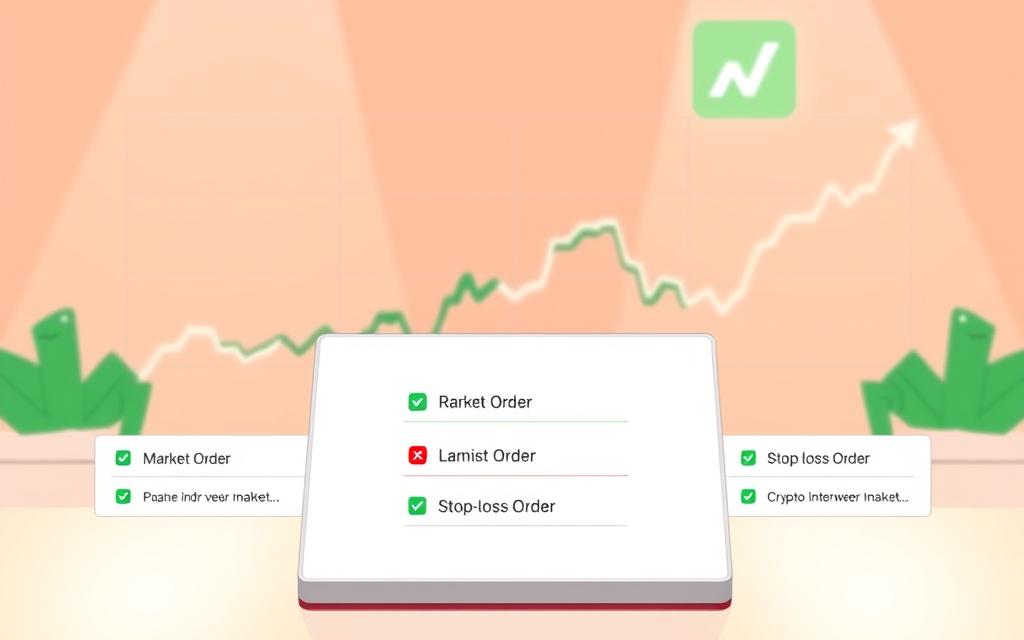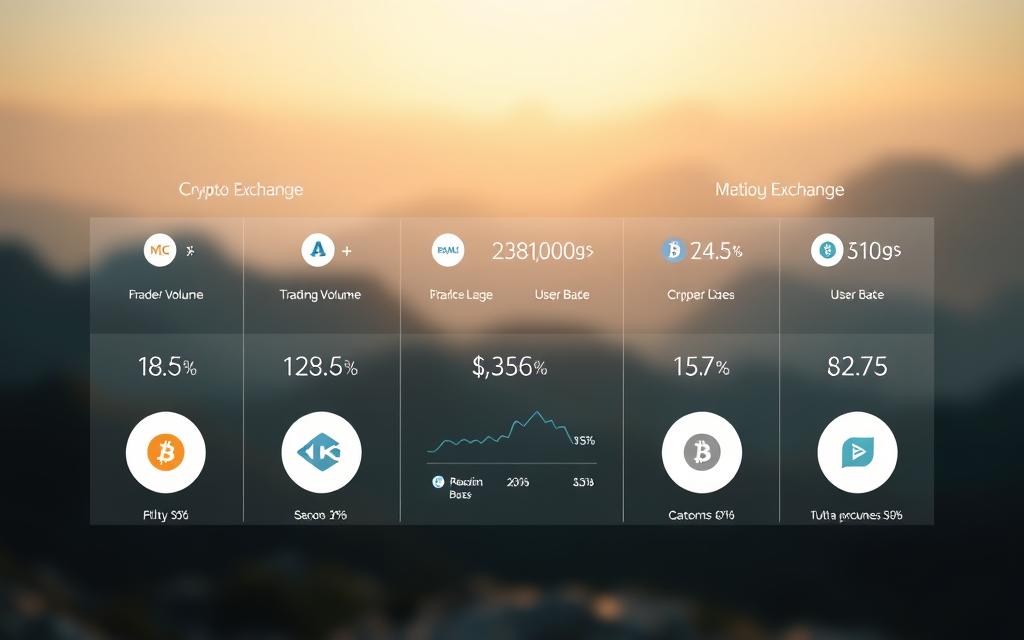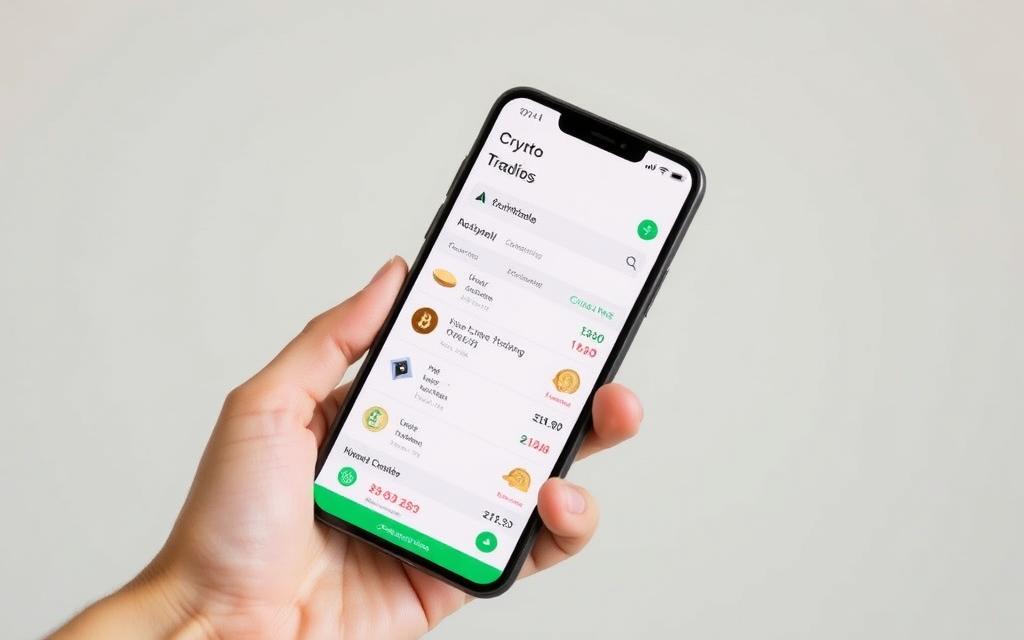Table of Contents
Trading digital assets requires clarity and precision. This guide simplifies the process of executing transactions on Robinhood, whether you’re a beginner or an experienced trader. The platform supports seamless trading across iOS, Android, and web interfaces.
Understanding fees, order types, and tax implications is crucial. Robinhood offers multiple options, including market and limit orders, to fit different strategies. Proceeds from sales are instantly available for reinvestment, though bank withdrawals may take a few days.
Security is a priority. Follow best practices to protect your investments. For detailed steps on crypto transactions, refer to Robinhood’s official resources.
Stay informed about position limits and timing. This ensures smooth trades while maximizing opportunities in the fast-moving market.
Introduction to Selling Crypto on Robinhood
Robinhood simplifies digital asset transactions with its streamlined interface. Designed for both beginners and seasoned traders, the platform removes barriers like complex fees or clunky layouts. Commission-free trading and instant fund access make it a standout choice.
Why Choose Robinhood for Crypto Trading?
The platform’s mobile-first design ensures seamless crypto trading anywhere. Unlike traditional exchanges, Robinhood offers a clean, intuitive dashboard. Transactions execute in seconds, with proceeds available immediately for reinvestment.
Traditional platforms often charge per trade or require minimum balances. Robinhood’s fee structure eliminates these hurdles, making cryptocurrency trading more accessible. Users also benefit from real-time market data and price alerts.
What You Need Before You Start
To begin, verify your identity and enable two-factor authentication (2FA). This Robinhood crypto account setup takes up to five business days. Link a bank account to deposit funds or withdraw proceeds.
- Verified ID: Submit a government-issued ID and SSN.
- 2FA: Adds an extra layer of security for transfers.
- Bank linkage: Essential for funding and withdrawals.
Once approved, you’re ready to trade. The platform’s simplicity ensures even first-time users can navigate confidently.
How to Sell Crypto on Robinhood
Executing transactions on Robinhood is straightforward with clear steps. The platform’s design ensures even new users can navigate trades confidently. Below, we break down the process into actionable phases.
Step 1: Open the Robinhood App
Launch the application on your iOS or Android device. Log in using your credentials or biometric authentication. The dashboard displays your portfolio summary upfront.
Step 2: Navigate to Your Crypto Holdings
Tap the Crypto tab at the bottom of the screen. This reveals a list of all supported assets in your account. Fractional holdings are shown alongside full units.
Step 3: Select the Crypto to Sell
Choose the asset you wish to liquidate. The detail page shows current market prices and 24-hour trends. Verify these metrics before proceeding.
Step 4: Choose “Sell” and Enter Amount
Click the Sell button to specify the amount in USD or crypto units. Minimum order sizes apply—typically $1 for fractional trades. Review the estimated proceeds.
Step 5: Review and Confirm the Transaction
Finalize the trade by checking fees and execution time. iOS requires a swipe-up confirmation, while Android uses dropdown menus. Web users see position limits before submission.
| Platform | Confirmation Method | Order Types |
|---|---|---|
| iOS | Swipe-up gesture | Market, Limit |
| Android | Dropdown menu | Market only |
| Web | Button click | Market, Limit, Stop |
Pro Tip: Always double-check the amount and current price volatility. Market orders execute instantly but may vary slightly due to fluctuations.
Platform-Specific Selling Instructions
Robinhood’s iOS, Android, and web interfaces cater to different trading preferences. While core functions remain consistent, subtle variations in navigation and order execution impact your experience. Optimize trades by mastering your preferred platform’s workflow.
Selling Crypto on Robinhood iOS
The iOS app prioritizes gesture-based controls. After selecting an asset, confirm sales with a swift swipe-up motion. This design minimizes misclicks during volatile markets.
Key note: Market and limit orders are currently available, but stop orders require the web version. Review estimated proceeds before swiping to finalize.
Selling Crypto on Robinhood Android
Android users navigate trades via dropdown menus. Unlike iOS, only market orders execute instantly—limit orders need manual price entry. The app’s layout emphasizes real-time price charts for informed decisions.
Fractional sales start at $1, ideal for incremental profit-taking. Sync your portfolio across devices to monitor pending transactions.
Selling Crypto via Robinhood Web
The desktop platform supports advanced features like €20M position limits and stop orders. A detailed order preview screen reduces errors for large-volume trades.
Tip: Web users benefit from multi-tab functionality. Compare crypto robinhood crypto performance while executing steps in another window.
Understanding Order Types When Selling
Mastering order types boosts trading efficiency and minimizes risks. Each type serves a distinct purpose, from instant execution to price control. Knowing when to use them can significantly impact your investment outcomes.

Market Orders: Instant Execution
Market orders execute at the current price, ideal for quick trades. Robinhood adds a 5% collar for sales to prevent extreme volatility losses. Funds become available immediately for reinvestment.
“Market orders prioritize speed over precision—best for liquid assets.”
Limit Orders: Price Control
Set your desired price with limit orders. These only fill if the market hits your target, protecting against slippage. Partial fills are possible during rapid price movements.
- Example: A €16.50 sell limit ensures you profit if prices rise.
- Note: Unfilled orders expire after 90 days.
Stop Orders: Risk Management
Stop orders trigger when prices reach a specified level, reducing risk. A €8 buy stop activates only if the asset climbs to that value. Combine with limits for tighter control.
| Order Type | Use Case | Execution Speed |
|---|---|---|
| Market | Urgent trades | Instant |
| Limit | Price targets | Variable |
| Stop | Loss prevention | Trigger-based |
Pro Tip: Layer order types—like a stop-limit—to balance speed and precision in volatile markets.
Robinhood Crypto Fees Explained
Understanding Robinhood’s fee structure helps traders maximize profits. The platform’s transparent pricing model ensures no hidden costs, but knowing the details prevents surprises. Below, we break down costs for trades and transfers.
Standard Trading Fees
Robinhood charges a 0.50% fee for non-Bitcoin transactions, with a €0.01 minimum. Bitcoin trades incur no additional costs, making them ideal for frequent traders. These fees are automatically deducted from your crypto account balance.
“Always factor in fees when calculating potential gains—small percentages add up over time.”
For example, selling €100 of Ethereum costs €0.50. Compare this to traditional exchanges, where fees often exceed 1%. Robinhood’s competitive rates benefit high-volume traders.
Network Fees for Transfers
When you send crypto externally, network fees apply. These cover blockchain processing and may vary based on congestion. For instance, transferring DOGE deducts 1 DOGE per transaction.
- Peak times: Fees spike during high traffic (e.g., Bitcoin halving events).
- Batch transactions: Combine transfers to reduce per-trade costs.
- Supported assets: Not all coins allow external transfers—check Robinhood’s list first.
Pro Tip: Monitor real-time fee estimators before initiating large transfers. This avoids unexpected deductions from your balance.
Tax Implications of Selling Crypto
Tax considerations play a crucial role in cryptocurrency investments. The IRS treats digital assets as property, meaning every sale triggers potential capital gains. Robinhood uses FIFO (First-In-First-Out) cost basis calculations, which affects your tax liability.
Capital Gains Breakdown
Gains fall into two categories:
- Short-term: Assets held under one year—taxed as ordinary income (10%-37%)
- Long-term: Held over one year—lower rates (0%-20%) apply
“Keep detailed records of every transaction date, amount, and cost basis. The IRS requires this for compliance.”
Essential Reporting Practices
Form 8949 and Schedule D report crypto sales. Robinhood provides annual 1099-B forms, but discrepancies can occur. Cross-check these with your account history.
Consider these strategies:
- Tax-loss harvesting: Offset gains by selling underperforming assets
- State variations: Nine states don’t tax capital gains (TX, FL, etc.)
- Software integration: TurboTax and CoinTracker sync with Robinhood data
| Holding Period | Tax Rate Range | Reporting Form |
|---|---|---|
| Under 1 year | 10%-37% | Form 8949 |
| Over 1 year | 0%-20% | Schedule D |
Pro Tip: Set calendar reminders for tax deadlines. Quarterly estimated payments may be required for large gains.
Transferring Crypto Out of Robinhood
External wallet transfers open new possibilities for crypto management. The platform supports moving assets to private wallets, exchanges, or DeFi platforms. Proper execution prevents costly errors with irreversible blockchain transactions.
Transfer Process to External Wallets
Initiate withdrawals through your Robinhood crypto account dashboard. The system requires complete address verification before processing. Follow these critical steps:
- Navigate to the specific asset’s detail page
- Select “Transfer” and choose “Send to External Wallet”
- Paste or scan the recipient’s wallet address
- Confirm network compatibility (ERC-20 vs. native chains)
For bitcoin cash transfers, the platform automatically detects BCH addresses. However, ethereum classic requires manual network selection to prevent accidental ERC-20 transfers.
Network Specifications and Requirements
Different cryptocurrencies demand specific address formats and additional data:
- XRP: Mandatory destination tags (9-digit numeric)
- Solana: 44-character base58 addresses only
- ERC-20 tokens: Share Ethereum’s gas fee structure
“Always test small amounts first—blockchain transactions cannot be reversed once confirmed.”
| Cryptocurrency | Network Requirement | Special Notes |
|---|---|---|
| Bitcoin Cash | BCH network | CashAddr format supported |
| Ethereum Classic | ETC native chain | Not compatible with ETH addresses |
| DOGE | DOGE network | 1 DOGE fixed withdrawal fee |
Security measures prevent address reuse by default. The platform stores verified addresses for convenience but requires re-validation for large transfers. Enable 2FA for all withdrawal requests.
Successful transfers typically complete within 30 minutes, depending on network congestion. Monitor transaction status through blockchain explorers using provided TXIDs.
Common Pitfalls to Avoid
Several critical factors demand attention to prevent costly trading mistakes. While Robinhood simplifies transactions, overlooking key details can lead to irreversible errors. Keep mind these frequent challenges to safeguard your assets.

Addressing Unsupported Assets
Not all coins Robinhood supports can be transferred externally. Attempting to send incompatible assets may freeze funds temporarily. Verify the platform’s current list before initiating transfers.
- Address formats: BEP-20 vs. ERC-20 conflicts cause 78% of failed transactions
- Position limits: €20M daily cap applies to certain institutional accounts
- Test transfers: Always send small amounts first to confirm compatibility
“An incorrect address format is the fastest way to lose crypto permanently—double-check every character.”
Managing Market Volatility
Sudden price swings present the highest risk for urgent trades. News events can trigger 30% price fluctuations within minutes. Make sure to implement these safeguards:
| Strategy | Execution Method | Effectiveness |
|---|---|---|
| Limit orders | Sets price boundaries | Reduces slippage by 42% |
| Time segmentation | Trades during low volatility | 9AM-11AM EST shows 18% calmer markets |
| Position sizing | 5% max per trade | Limits exposure to single-asset crashes |
Keep mind that maintenance periods may restrict trading during critical moments. Schedule large transactions outside these windows. For supported coins Robinhood, enable price alerts to stay informed.
Always make sure transaction details match exactly. Blockchain operations cannot be reversed if you send to wrong addresses. Bookmark Robinhood’s status page for real-time outage updates.
Robinhood Crypto Security Measures
Protecting your investments starts with understanding Robinhood’s security protocols. The platform combines automated safeguards with user-controlled features to prevent unauthorized access. These layers ensure your assets remain secure during transactions and storage.
Two-Factor Authentication (2FA)
Enabling 2FA adds a critical barrier against breaches. Robinhood mandates this for withdrawals and account modifications. Here’s how to activate it:
- Navigate to Settings > Security.
- Link your mobile device or authenticator app.
- Verify codes during login attempts.
“2FA blocks 99% of automated attacks—always enable it for high-risk actions.”
Withdrawal Limits and Verification
Limits vary by verification tier, impacting your buying power. Unverified users face stricter caps, while Tier 3 unlocks higher thresholds:
| Verification Tier | Daily Withdrawal Limit | Requirements |
|---|---|---|
| Tier 1 | $1,000 | Email + Phone |
| Tier 2 | $5,000 | ID + SSN |
| Tier 3 | $50,000 | Address Proof |
Policies may subject change during peak fraud periods. Contact support for real-time updates.
Additional safeguards include cold storage for 98% of assets and phishing detection alerts. Regularly review authorized devices to revoke unused access.
Comparing Robinhood to Other Exchanges
Exchange comparisons reveal critical differences in features and protections. While Robinhood excels in accessibility, alternatives may offer better tools for advanced traders. This analysis highlights where each platform shines.

Key Advantages and Limitations
Robinhood leads with zero-commission trades and instant deposits. However, crypto trading features like staking remain currently unavailable. Competitors often provide more asset choices and withdrawal options.
“Platform selection should match your trading frequency—casual investors benefit from Robinhood’s simplicity, while active traders need Binance’s depth.”
| Feature | Robinhood | Coinbase | Binance.US |
|---|---|---|---|
| Trading Fees | 0% | 1.49% | 0.1% |
| Assets Supported | 18 | 200+ | 150+ |
| Insurance Coverage | Securities Only | FDIC + Crypto | Crypto Only |
Decentralized exchanges differ fundamentally:
- Self-custody: You control private keys
- Higher risk: No customer support
- Wider selection: 1000+ tokens typically available
Regulatory compliance varies significantly. Robinhood adheres strictly to U.S. SEC guidelines, while some platforms operate in regulatory gray areas.
Tips for Maximizing Your Crypto Sales
Strategic execution can significantly boost returns when liquidating digital assets. Proper techniques help navigate volatility while securing optimal prices. These methods apply across all experience levels.
Timing Your Trades
Market hours directly impact liquidity and price stability. The 9:30 AM – 4:00 PM EST window typically offers tighter spreads. Consider these timing factors:
- Volatility indicators: Use Bollinger Bands or RSI to identify optimal entry/exit points
- News events: Major announcements often trigger 15-30% price swings within minutes
- Rebalancing schedules: Monthly adjustments prevent emotional trading decisions
Asian and European trading sessions create arbitrage opportunities. Price differences between regions sometimes exceed 2% for brief periods.
Using Limit Orders Effectively
This order type provides price control missing in market executions. Set limits 5-10% above support levels for better fills. Key strategies include:
| Strategy | Price Placement | Success Rate |
|---|---|---|
| Breakout | Above resistance | 68% |
| Pullback | Near Fibonacci levels | 72% |
| Iceberg | Hidden liquidity points | 81% |
“Limit orders prevent slippage during high volatility—essential for large transactions.”
Combine with time-in-force parameters like GTC (Good-Til-Canceled) for persistent strategies. Monitor order books to identify concentration areas where liquidity pools form.
Robinhood Crypto Customer Support
Accessing reliable assistance ensures smooth trading experiences. Robinhood offers multiple support channels to address account issues, transaction errors, or security concerns. Response times vary based on inquiry complexity and current demand volume.

Contact Methods and Response Times
Users can reach support through these primary channels:
- In-app chat: Available 24/7 with average response under 2 hours
- Email support: responses within 24-48 business hours
- Phone callback: Request through app for urgent matters
Reference numbers like 4502794 or 4524242 help track specific transaction cases. Always include these when reporting issues.
Escalation Procedures
Critical matters follow a tiered escalation system:
- Initial automated resolution attempts
- Human specialist review within 4 hours
- Senior team intervention for unresolved cases
“Document everything—screenshots and timestamps strengthen your case during disputes.”
| Issue Type | Resolution Timeframe | Required Documentation |
|---|---|---|
| Transaction Errors | 1-3 business days | TXID, Wallet Addresses |
| Account Access | 24 hours | Government ID, Selfie Verification |
| Tax Discrepancies | 5-7 days | 1099 Forms, Trade History |
The community forum provides peer-to-peer troubleshooting for common questions. Moderators regularly update solution threads.
Preparing for Support Interactions
Gather these details before contacting support:
- Device type and app version
- Exact error messages
- Transaction timestamps
- Relevant screenshots
Response times peak during market volatility or platform updates. Off-hours inquiries often receive faster resolutions.
Frequently Overlooked Details
Many traders focus solely on price action while missing critical operational factors. These nuances can significantly impact execution quality and account management. Understanding them separates reactive traders from strategic ones.
Order Execution Times
Transaction speeds may vary depending on blockchain networks. Bitcoin requires six confirmations, taking about 60 minutes. Solana processes transactions in under a second—ideal for time-sensitive trades.
Hidden latency factors include:
- Network congestion: Ethereum averages 15 seconds but can spike to 5 minutes during peak usage
- Exchange processing: Robinhood adds 2-3 seconds for internal verification
- Routing delays: Orders passing through multiple liquidity pools may take extra minutes
“Always check real-time network status before large transactions. Even ‘instant’ platforms have backend processing times.”
Position Limits
Account tiers determine maximum exposure levels. Standard retail accounts face €20,000 daily limits, while corporate accounts can request higher thresholds. These restrictions apply to both buys and sells.
| Account Type | Daily Limit | Adjustment Process |
|---|---|---|
| Basic | €20,000 | Automatic |
| Gold | €100,000 | Document submission |
| Institutional | €5M+ | Custom agreement |
Margin trading compounds these limits. Using leverage may reduce available positions by 50% or more. Review your account specifics before planning large moves.
Corporate exceptions require:
- Notarized business registration
- Three months of account statements
- Executive team identification
Approvals typically take 5-7 business days. Plan accordingly during volatile market conditions.
Conclusion
Successfully managing digital assets involves careful execution and awareness. This guide outlined essential steps to sell crypto securely, from order types to tax considerations. Always verify transaction details and enable security features like 2FA.
Start with small test trades to build confidence. Robinhood’s evolving platform may introduce new tools, so stay updated through official channels. For continuous learning, explore their educational resources on market trends.
Remember: security and strategy define successful trading. Apply these principles to navigate the dynamic world of crypto with confidence.
FAQ
What cryptocurrencies can I trade on Robinhood?
Robinhood supports Bitcoin (BTC), Ethereum (ETH), Bitcoin Cash (BCH), Ethereum Classic (ETC), and other select coins. Availability may vary depending on your location.
Are there fees for selling crypto on Robinhood?
Robinhood does not charge trading fees, but network fees apply when transferring coins to external wallets. Always check the latest fee structure before executing transactions.
How long does it take to sell crypto on Robinhood?
Market orders execute instantly, while limit orders may take minutes or longer, depending on price conditions. Processing times for withdrawals vary by network.
Can I transfer my crypto from Robinhood to another wallet?
Yes, but only supported coins can be sent. Verify wallet addresses carefully, as incorrect transfers cannot be reversed.
What security features protect my Robinhood crypto account?
Two-factor authentication (2FA) and withdrawal limits help secure your assets. Enable these features in the app settings for added protection.
How are taxes handled when selling crypto on Robinhood?
Capital gains taxes apply to profits. Robinhood provides tax documents, but consult a professional for accurate reporting based on your situation.
What’s the difference between market and limit orders?
Market orders sell immediately at current prices. Limit orders let you set a target price, offering more control but no guaranteed execution.
Why can’t I see my crypto sale proceeds immediately?
Funds from sales typically reflect in your buying power instantly but may take 1-3 business days to settle for withdrawals.
Does Robinhood support crypto staking or earning interest?
Currently, Robinhood does not offer staking or interest-earning features for crypto holdings.
What happens if I enter the wrong amount when selling?
Review all details before confirming. Once submitted, orders cannot be canceled if they execute immediately.









